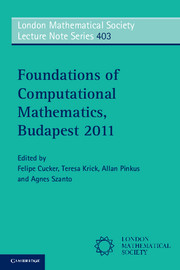Book contents
- Frontmatter
- Contents
- Preface
- Contributors
- 1 The State of the Art in Smale's 7th Problem
- 2 The Shape of Data
- 3 Upwinding in Finite Element Systems of Differential Forms
- 4 On the Complexity of Computing Quadrature Formulas for SDEs
- 5 The Quantum Walk of F. Riesz
- 6 Modulated Fourier Expansions for Continuous and Discrete Oscillatory Systems
- 7 The Dual Role of Convection in 3D Navier-Stokes Equations
- 8 Algebraic and Differential Invariants
- 9 Through the Kaleidoscope: Symmetries, Groups and Chebyshev-Approximations from a Computational Point of View
- 10 Sage: Creating a Viable Free Open Source Alternative to Magma, Maple, Mathematica, and MATLAB
- References
1 - The State of the Art in Smale's 7th Problem
Published online by Cambridge University Press: 05 December 2012
- Frontmatter
- Contents
- Preface
- Contributors
- 1 The State of the Art in Smale's 7th Problem
- 2 The Shape of Data
- 3 Upwinding in Finite Element Systems of Differential Forms
- 4 On the Complexity of Computing Quadrature Formulas for SDEs
- 5 The Quantum Walk of F. Riesz
- 6 Modulated Fourier Expansions for Continuous and Discrete Oscillatory Systems
- 7 The Dual Role of Convection in 3D Navier-Stokes Equations
- 8 Algebraic and Differential Invariants
- 9 Through the Kaleidoscope: Symmetries, Groups and Chebyshev-Approximations from a Computational Point of View
- 10 Sage: Creating a Viable Free Open Source Alternative to Magma, Maple, Mathematica, and MATLAB
- References
Summary
A very brief historical note
Smale's 7th problem is the computational version of an old problem dating back to Thomson [30] and Tammes [29], see Whyte's early review [32] for its history, namely, the sensible distribution of points in the two- dimensional sphere. In Whyte's paper different possible definitions of “well-distributed points in the sphere” are suggested:
1. Points which maximise the product of their mutual distances (called elliptic Fekete points after [14]).
2. Points which minimise the sum of the inverse of their mutual distances (Thomson's problem), and more generally which minimise some sum of potentials which depend on the mutual distances (like Riesz potentials).
3. Points which maximise the least distance between any pair.
4. Points which are the center of the optimal packing problem, that is, the problem of finding the smallest radius of a sphere such that one can place on its surface k non-overlapping circles of a given radius.
This beautiful problem is terribly challenging! A first shocking result by Leech [19] showed that even though the set of N particles on the sphere which are critical points for the problem in item (2) for every possible potential can be completely described, this description is not enough to solve the problem for any particular potential. Namely, solving problem (2) for some particular potential may be completely meaningless for solving problem (2) for another, different potential.
- Type
- Chapter
- Information
- Publisher: Cambridge University PressPrint publication year: 2012



